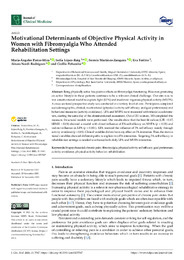Por favor, use este identificador para citar o enlazar este ítem:
https://hdl.handle.net/11000/31318Registro completo de metadatos
| Campo DC | Valor | Lengua/Idioma |
|---|---|---|
| dc.contributor.author | Pastor-Mira, María Ángeles | - |
| dc.contributor.author | López Roig, Sofía | - |
| dc.contributor.author | Martínez-Zaragoza, Fermín | - |
| dc.contributor.author | Toribio, Eva | - |
| dc.contributor.author | Nardi-Rodríguez, Ainara | - |
| dc.contributor.author | Peñacoba, Cecilia | - |
| dc.contributor.other | Departamentos de la UMH::Ciencias del Comportamiento y salud | es_ES |
| dc.date.accessioned | 2024-02-08T13:41:48Z | - |
| dc.date.available | 2024-02-08T13:41:48Z | - |
| dc.date.created | 2021-11 | - |
| dc.identifier.citation | Journal of Clinical Medicine (JCM) 2021, 10(23) | es_ES |
| dc.identifier.issn | 2077-0383 | - |
| dc.identifier.uri | https://hdl.handle.net/11000/31318 | - |
| dc.description.abstract | Being physically active has positive effects on fibromyalgia functioning. However, promoting an active lifestyle in these patients continues to be a relevant clinical challenge. Our aim was to test a motivational model to explain light (LPA) and moderate-vigorous physical activity (MVPA). A cross-sectional prospective study was conducted at a tertiary level of care. Participants completed sociodemographic, clinical, motivational (physical activity self-efficacy and goal preferences) and behavioral measures (activity avoidance). LPA and MVPA were measured with triaxial accelerometers, starting the same day of the aforementioned assessment. Out of 211 women, 183 completed this measure. Structural models were performed. Our results show that the best fit indices (CFI = 0.97, SRMR = 0.04) showed a model with direct influence of PA self-efficacy on MVPA (p < 0.01) and indirect influence on LPA (p < 0.001). LPA received the influence of PA self-efficacy mainly through activity avoidance (p < 0.01). Clinical variables did not have any effect on PA intensities. Thus, the motivational variables showed different paths to explain two PA intensities. Targeting PA self-efficacy in rehabilitation settings is needed to enhance both daily LPA and MVPA intensities | es_ES |
| dc.format | application/pdf | es_ES |
| dc.format.extent | 13 | es_ES |
| dc.language.iso | eng | es_ES |
| dc.publisher | MDPI | es_ES |
| dc.rights | info:eu-repo/semantics/openAccess | es_ES |
| dc.rights | Attribution-NonCommercial-NoDerivatives 4.0 Internacional | * |
| dc.rights.uri | http://creativecommons.org/licenses/by-nc-nd/4.0/ | * |
| dc.subject | biopsychosocial | es_ES |
| dc.subject | chronic pain | es_ES |
| dc.subject | fibromyalgia | es_ES |
| dc.subject | physical activity self-efficacy | es_ES |
| dc.subject | goal preferences | es_ES |
| dc.subject | activity avoidance | es_ES |
| dc.subject | physical activity behavior | es_ES |
| dc.subject.other | CDU::6 - Ciencias aplicadas::61 - Medicina::613 - Higiene en general. Higiene y salud personal | es_ES |
| dc.title | Motivational Determinants of Objective Physical Activity in Women with Fibromyalgia Who Attended Rehabilitation Settings | es_ES |
| dc.type | info:eu-repo/semantics/article | es_ES |
| dc.relation.publisherversion | https://doi.org/10.3390/jcm10235547 | es_ES |

Ver/Abrir:
5-OA-Published manuscript-JCM (1).pdf
966,98 kB
Adobe PDF
Compartir:
 La licencia se describe como: Atribución-NonComercial-NoDerivada 4.0 Internacional.
La licencia se describe como: Atribución-NonComercial-NoDerivada 4.0 Internacional.
.png)